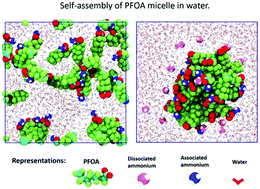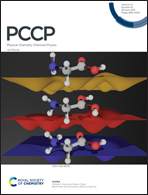Controlling the self-assembly of perfluorinated surfactants in aqueous environments†
Abstract
Surface active per- and polyfluoroalkyl substances (PFAS) released in the environment generate great concern in the US and worldwide. The sequestration of PFAS amphiphiles from aqueous media can be limited by their strong tendency to form micelles that plug the pores in the adsorbent material, rendering most of the active surface inaccessible. A joint experimental and simulation approach has been used to investigate the structure of perfluorooctanoate ammonium (PFOA) micelles in aqueous solutions, focusing on the understanding of ethanol addition on PFOA micelle formation and structure. Structurally compact and slightly ellipsoidal in shape, PFOA micelles in pure water become more diffuse with increasing ethanol content, and break into smaller PFOA clusters in aqueous solutions with high ethanol concentration. A transition from a co-surfactant to a co-solvent behavior with the increase of ethanol concentration has been observed by both experiments and simulations, while the latter also provide insight on how to achieve co-solvent conditions with other additives. An improved understanding of how to modulate PFAS surfactant self-assembly in water can inform the fate and transport of PFAS in the environment and the PFAS sequestration from aqueous media.



 Please wait while we load your content...
Please wait while we load your content...
